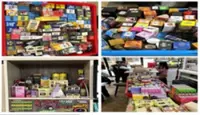Bernadine showing a bottle of his mulberry wine.
As I read the calling card handed to me by Bernardine Philip, I’m struck by the term he uses to describe his occupation – “vintner”.
The Merriam-Webster dictionary defines vintner as both a wine merchant and a wine maker. In Bernardine’s case, both definitions fit him perfectly.
Already a subscriber? Log in
Save 30% OFF The Star Digital Access
Cancel anytime. Ad-free. Unlimited access with perks.





